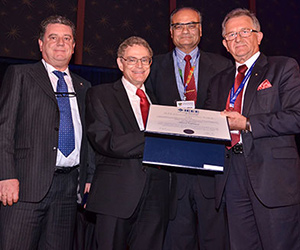Taflove Presented with 2014 IEEE Electromagnetics Award at IEEE Antennas and Propagation Society International Symposium
This IEEE-wide award (a "Technical Field Award") is the most significant annual international recognition in engineering electromagnetics. It consists of a $10,000 prize and an inscribed bronze medal.

This IEEE-wide award (a "Technical Field Award") is the most significant annual international recognition in engineering electromagnetics. It consists of a $10,000 prize and an inscribed bronze medal.
The inscription for Prof. Taflove's award reads, "For contributions to the development and application of finite-difference time-domain (FDTD) solutions of Maxwell's equations across the electromagnetic spectrum." Attendance at the ceremony's banquet exceeded 600 people, with at least 50% from outside the U.S.A.
Prof. Taflove is considered the researcher most responsible for the worldwide use of FDTD methods for solving scientific and engineering problems involving electromagnetic wave interactions with material objects. Since 1972, he has pioneered fundamental theory, algorithms, and applications of this numerical technique for Maxwell's equations. Through his research, FDTD has become the primary method to model complex electromagnetic interactions ranging across the spectrum from ultralow-frequency geophysical phenomena spanning the entire Earth to nanometer-scale photonics.
Nature Milestones|Photons has named Prof. Taflove as one of the two principal pioneers of numerical solutions of Maxwell's equations.
According to Google Scholar, his publications have received more than 26,500 citations, and the exact phrase "finite difference time domain" which he coined in 1980 has appeared in approximately 70,000 search results. Allen's major publication, Computational Electrodynamics: The Finite-Difference Time-Domain Method, is the 7th most-cited book in physics according to the University of Rochester's Institute of Optics, currently with more than 13,000 Google Scholar citations.
Since 2003, Prof. Taflove has collaborated with Prof. Vadim Backman, Professor of Biomedical Engineering. FDTD modeling has helped to establish the fundamental physics foundation of Prof. Backman's spectroscopic microscopy technique for early detection of cancers of the colon, lung, pancreas, and ovaries (Read More: Physical Review Letters & Nature.com articles).
In preclinical trials involving hundreds of human subjects, spectroscopic microscopy has demonstrated better than 90% sensitivity and specificity in detecting deeply-seated cancers by scanning cells brushed from accessible body cavities. This technique has the potential to save many thousands of lives each year.
Read More:
